Ginkgo Tree: Leaves, Bark, Flower, Fruit (Pictures) – Identification

Ginkgo biloba tree is a spectacular deciduous ornamental tree with large fan-shaped leaves that turn a stunning buttery-yellow color in the fall. The unusual ginkgo tree leaves create dense foliage and form a pyramidal crown on this tall, elegant shade tree. Also called the maidenhair tree, the ginkgo tree thrives in loamy, well-drained soil, full sun to partial shade, and in growing zones 3 to 9.
This article is a guide to identifying the Ginkgo biloba tree. Descriptions and pictures of the tree leaves, fruit, and other identifying characteristics will help you recognize the ginkgo trees in landscapes.
Gingko Tree Facts

Ginkgo trees in autumn
Ginkgo biloba is the only species of tree left in the genus Ginkgo and the family Ginkgoaceae. The ginkgo tree (sometimes written as gingko) is also in the family of gymnosperms, which means the imposing tree is closely related to conifers. And, like conifers, ginkgo trees don’t produce true flowers.
Ginkgo trees grow 50 to 75 ft. (15 – 23 m) high with a broadly spreading pyramidal crown that grows up to 60 ft. (18 m) wide. As the slow-growing tree matures, the branches start to droop and may need pruning for clearance below its low canopy. However, the strong branches and trunk of ginkgo trees mean it’s resistant to breakage.
An interesting fact about ginkgo trees: Four ginkgo trees survived the Hiroshima bombing in 1945 and are still thriving in Japan today.
Ginkgo trees are some of the oldest trees in the world where they are native to China and the Far East. Ginkgoes are referred to as living fossils because the species has remained unchanged since the Jurassic period.
Ginkgo biloba trees have an important place in Asian culture. It is said that Confucius sat under a ginkgo tree, spending hours thinking, reading, and writing. Additionally, ginkgo tree leaves are used as bookmarks in Japan because they contain chemical properties that protect books from booklice. Extracts from ginkgo are widely used in traditional Chinese medicine.
Male Ginkgo Tree Vs. Female Ginkgo Tree
Ginkgo trees are classed as dioecious, meaning the male and female trees are separate trees. The differences between male and female ginkgo trees are the type of “flowers” and the fleshy seed they produce. Female ginkgo trees are known for the messy fruit that smells bad.
Male ginkgo tree

Male ginkgo tree
The male Ginkgo biloba tree is identified by its long drooping cones that “bloom” in mid-spring. The seed-bearing cones also produce pollen. The finger-like catkins grow spirally, arranged around a central axis. Often, pictures of male ginkgo trees show the green catkins growing together with new leaves.
Female ginkgo tree
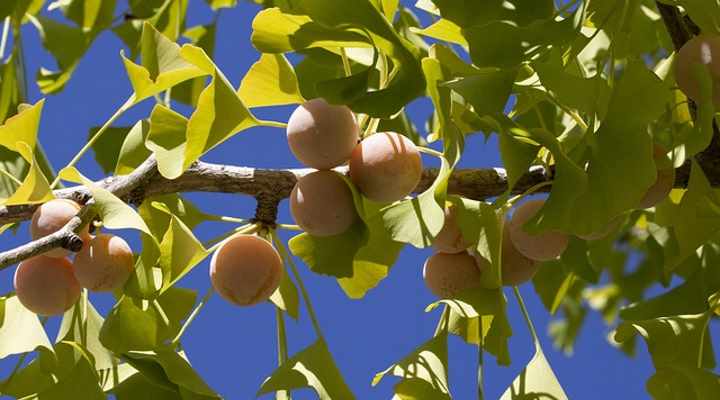
Female ginkgo tree
The female Ginkgo biloba tree is identified by its orangey globular fruits growing in dangling clusters. Each round fruit contains a single large seed. The main complaint of the ginkgo tree is the offensive stink from the fruit. Also, the slimy flesh of the female ginkgo fruit is particularly messy.
People say that the stench from fallen ginkgo tree “fruit” smells like raw dog vomit, dog feces, or rancid butter.
It is impossible to tell a male ginkgo apart from the female tree before it’s planted. Because a ginkgo tree takes 15 to 20 years to produce fruit, it can be a long time before you know if you have a male ginkgo tree or smelly female ginkgo tree.
Ginkgo Tree Leaves

Ginkgo leaves
Ginkgo biloba tree leaves are unique among species of trees. The ginkgo leaves are fan-shaped with rounded lobes and veins radiating out. Leaves on ginkgo trees grow 2” to 4” (5 – 10 cm) long, with some of the larger leaves being 6” (15 cm) long. Ginkgo leaves turn beautiful shades of bright yellow in the fall.
The botanical name of ginkgo trees refers to the unusual leaf shape. Biloba means rounded lobe and describes the two lobes that commonly make up ginkgo leaves.
Ginkgo biloba leaves also resemble maidenhair fern (Adiantum) leaves. This is the reason why the ginkgo tree also has the common name maidenhair tree.
A characteristic feature of ginkgo leaves is that they shed fairly quickly in the fall. This habit of the ginkgo tree creates a spectacular golden yellow mat beneath the tree. Because of its stunning fall color, the ginkgo tree is popular in urban landscapes
Ginkgo Tree Flower
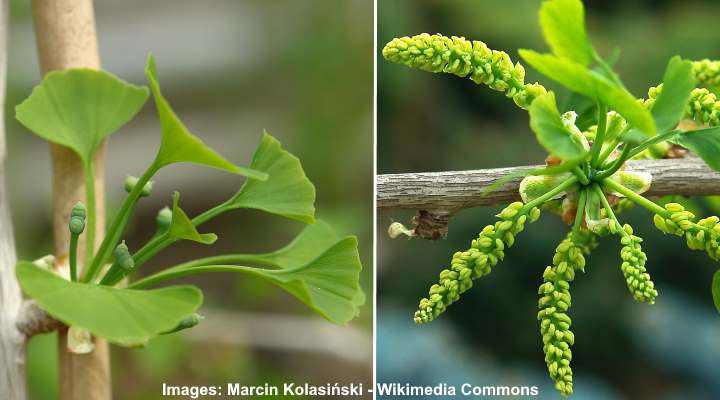
Ginkgo “flowers”: female (left) and male (right)
Ginkgo biloba flowers are not true flowers in the botanical sense. The male trees produce yellowish-green finger-like shoots that are referred to as flowers. The 3” (8 cm) long “flowers” produce pollen to reproduce with the female tree. Flowers on female ginkgo trees look like long green stalks with ovules at the end.
Gingko trees belong to the class of non-flowering gymnosperm plants. These plants produce seeds that aren’t enclosed in an ovary and don’t develop fruits. Ginkgo tree “flowers” bloom in April and May and are inconspicuous plant parts that emerge along with the leaves.
Ginkgo Nuts (Gingko Fruit)
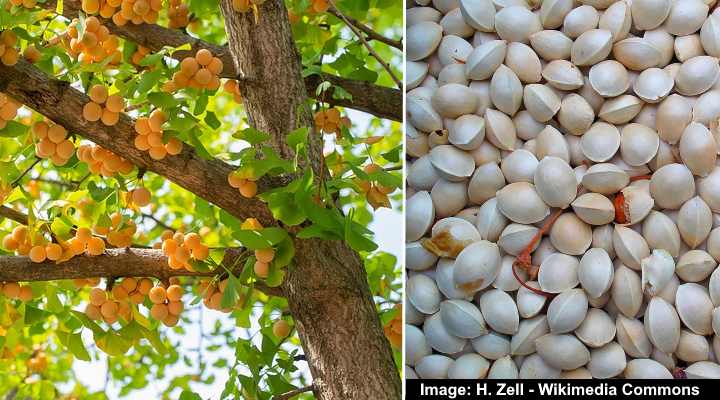
Ginkgo fruit (left) and the nuts inside (right)
Ginkgo biloba fruits are small round flesh-covered seeds growing on the end of a long stem. Also called ginkgo nuts, the crabapple-like fruits are the size of a cherry and turn from white to yellow-orange as they ripen. The fleshy-coated seeds are edible in moderation; however, the seeds contain certain mild toxic chemicals. Some of them break down when the nut is cooked, hence can be eaten in small quantities.
Ginkgo fruit is famous for causing a stinking mess. A single ginkgo tree produces abundant soft “fruits” that have slimy, foul-smelling flesh that squashes easily underfoot. The squashed fruit then gives off a foul aroma that some likened to Camembert cheese that has gone off or vomit.
Ginkgo Tree Identification
The easiest way to identify a Ginkgo biloba tree is by its green, leathery, fan-shaped leaves with two rounded lobes. The rich green leaves turn bright yellow in the fall. The ginkgo tree is also identified by its light gray or brown bark, and orangey-yellow cherry-like fruits that emit an identifiable stench when they fall.
Ginkgo tree bark
Common Ginkgo Tree Varieties
Although there is only one species of Ginkgo biloba tree, there are numerous varieties and cultivars. Most people look for male ginkgo trees to avoid the disgusting odor of ginkgo fruits. Here are a few of the best ginkgo trees for garden landscapes:
‘Fairmount’—A columnar ginkgo tree with a narrow, upright growth habit. Ideal for narrow spaces, the ginkgo ‘Fairmont’ grows 50 to 75 ft. (15 – 22 m) tall and up to 15 ft. (4.5 m) wide. This is a male tree, so it won’t produce stinky fruit.
Ginkgo biloba ‘Fairmount’
‘Autumn Gold’—A male variety of Ginkgo biloba famous for its bright yellow fall foliage. The ginkgo tree has a broadly conical crown and grows 50 ft. (15 m) tall and 30 ft. (9 m) wide.
Ginkgo biloba ‘Autumn Gold’
‘Chase Manhattan’—A shrub-like ginkgo tree that is a dwarf cultivar. Also called ‘Bon’s Dwarf,’ this short ginkgo tree grows 6 ft. (1.8 m) tall and has smaller leaves than typical ginkgoes.
Ginkgo biloba ‘Chase Manhattan’
‘Majestic Butterfly’—This spectacular variegated ginkgo tree has fan-shaped green leaves with streaked yellow variegation. The small ginkgo tree grows up to 10 ft. (3 m) tall.
‘Pendula’—Its umbrella-shaped crown and large leaves identify this ginkgo male tree cultivar. Not quite a weeping ginkgo tree, the branches arch form a vast canopy up to 10 ft. (3 m) in diameter. Grows up to 8 ft. (2.4 m) tall.
How to Use Ginkgo Trees in Landscapes
Ginkgo biloba trees are attractive landscaping trees due to their characteristic fan-shaped leaves that turn golden yellow in the fall. In addition, a ginkgo’s tall stature and broad, spreading crown make them ideal shade trees in large gardens. Ginkgo trees are also highly resistant to pests and diseases, making them easy to care for.
If you have a small, compact garden, plenty of all-male dwarf cultivars are to choose from. This ensures that your yard isn’t covered in foul-smelling, slippery fruits when they drop in the fall.
How to Grow a Ginkgo Tree in Garden Landscapes
Ginkgo trees are hardy and survive a wide range of environmental conditions
Despite being the world’s oldest tree species, Ginkgo biloba is easy to grow in garden landscapes. In addition, the hardy trees are tolerant of several environmental conditions such as cold, heat, drought, pests, disease, poor soil, and urban pollution.
Here are some handy tips on growing a ginkgo biloba tree in your front or backyard.
Plant a maidenhair tree in full sun or partial shade where it gets between four and six hours of sunshine daily. In hotter climates, ginkgo grows best in partial sun because extreme heat can affect its growth. During long, dry spells during summer, keep the tree well-watered to ensure healthy growth.
Ginkgo trees thrive in a wide range of soil conditions. Regardless of the type of soil—whether acidic or alkaline—ginkgo will grow well in well-drained soil. Sandy or loamy soil is best for the fastest growth. However, ginkgo is also tolerant of compacted soil or clay soil.
Maidenhair trees are suitable for growing in USDA zones 3 to 9 and survive a wide range of temperatures and moisture conditions. However, ginkgo growth can suffer in hot, dry climates. On the other hand, a mature established ginkgo tree is relatively tolerant of drought in moderate heat.
How to Water a Ginkgo Tree — Ginkgo Water Requirements
Like most landscape trees, a ginkgo tree has moderate water requirements. Mature ginkgo trees only require additional watering in arid conditions or prolonged sunshine. A newly planted ginkgo tree needs watering a few times a week to help establish a deep root system. Ginkgo trees don’t perform well in waterlogged ground.
To water a ginkgo tree, use a hose to soak the ground thoroughly at the root area. Ensure that you provide enough water for the moisture to penetrate down to the roots. But it’s good to remember that you only need to water a ginkgo occasionally, and usually only when the weather is hot and dry. In typical conditions, regular rainfall is enough to water this ancient tree.
The most critical factor when deciding where to plant a tree is that the ground is well-draining.
Ginkgo Tree Fertilization — How to Fertilize Ginkgo
Maidenhair trees benefit from fertilization in late winter or early spring. Because ginkgo isn’t a species of flowering tree, you can use a balanced slow-release tree fertilizer with an NPK rating of 12-12-12. Instead of fertilizing the ginkgo, you can apply rotted manure or a layer of compost to the root area.
It isn’t necessary to fertilize a newly planted ginkgo tree. Instead, regularly water the plant during the growing seasons of the first two years. Then, from year three, you can apply a balanced tree fertilizer twice a year.
It’s also a good idea to avoid fertilizing ginkgo trees during drought or winter. Additionally, you don’t need to apply fertilizer to a ginkgo tree if it’s growing beside a fertilized lawn. The root system will absorb nutrients from the lawn fertilizer.
How to Prune a Ginkgo Tree — Advice for Trimming Ginkgo
It is best to prune a maidenhair tree during its dormancy—late fall, winter, or early spring. Pruning during the winter months allows the tree time to heal before it starts growing vigorously in spring. The only yearly pruning you need is to remove dead branches, suckers, or drooping branches.
It’s only necessary to prune a ginkgo tree until it reaches 6 ft. (1.8 m) tall. After that, trim the ginkgo tree branches according to the tree’s growth. A columnar ginkgo tree, ginkgo with a spreading canopy, or a dwarf ginkgo tree has different pruning requirements.
After the ginkgo tree grows more than 6 ft. (1.8 m), you can stop yearly pruning. A mature ginkgo tree only requires trimming to remove dead or decaying branches or if you need to increase clearance from the tree’s canopy to the ground.
Ginkgo Propagation — How to Propagate and Root Ginkgo Cuttings
One of the easiest and fastest ways to propagate a maidenhair tree is by using cuttings. First, take branch cuttings in early summer, making sure they are 6” to 7” (15 – 18 cm) long. Next, put the cut ends into a light potting soil mix that is amended with perlite. Ensure that the soil is kept moist but not too damp. It takes six to eight weeks for ginkgo cuttings to root.
Suppose you are taking ginkgo tree cuttings from a street tree. In that case, it’s best to check that you take cuttings from a male tree. So, in late spring or early summer, look for the characteristic arching yellowish-green catkins growing on male trees. This helps you avoid problems with rancid-smelling fruit in the fall.
Propagating Ginkgo from Seed — How to Plant Ginkgo Seeds
You can propagate a ginkgo tree from the seed inside the ginkgo’s berry-like fruits that you can collect during late fall. The ginkgo nut is surrounded by a fleshy pulp that you should remove. When collecting the seeds, you should wear gloves because the seed’s outer layer can cause dermatitis.
To germinate ginkgo seeds, dampen a paper towel and put it in a sealable plastic bag. Place the seeds on the paper towel and then fold it over the seeds and seal the bag. Place in a warm, bright place for six weeks. After that time, put the sealed bag in the refrigerator to mimic the native cold winters that ginkgo trees experience.
After three months, remove the seeds and rub them with sandpaper to scratch the outer layer. Use a mixture of moist peat moss and perlite to create the ideal germinating environment. Put the seeds in the soil, so they are lightly covered. Cover with plastic and put in a warm place.
Keep the soil moist, and germination should take place in one to two months. When the seeds sprout, remove from the plastic bag and grow as normally.
Ginkgo biloba is a slow-growing tree. So you can enjoy a ginkgo tree as a beautiful houseplant for many years before you need to plant it in the garden.
Ginkgo biloba trees are also popular bonsai trees if you don’t have room in your garden for a large shade tree.

Ginkgo bonsai tree
How to Deal with Pests Affecting Ginkgo Growth
Ginkgo trees are relatively immune to the effects of pests such as spider mites, mealybugs, or aphids. Occasionally, caterpillars can munch on ginkgo foliage, but this is relatively rare. If you notice caterpillars, removing them by hand and dropping them in soapy water is enough to kill them and protect your tree.
How to Control Diseases Affecting Ginkgo Tree Growth
Ginkgo biloba is a tree species that has been growing for millions of years. So, it’s not surprising that the trees are generally resistant to diseases. However, sometimes disease affecting ginkgo tree roots can cause growth issues. To avoid diseases like phytophthora root rot, always ensure that the ground drains well and water doesn’t pool around the root areas.
Related articles:
- Small or Dwarf Evergreen Trees
- Types of Flowering Trees with Pictures
- Small or Dwarf Weeping Trees for Landscaping
